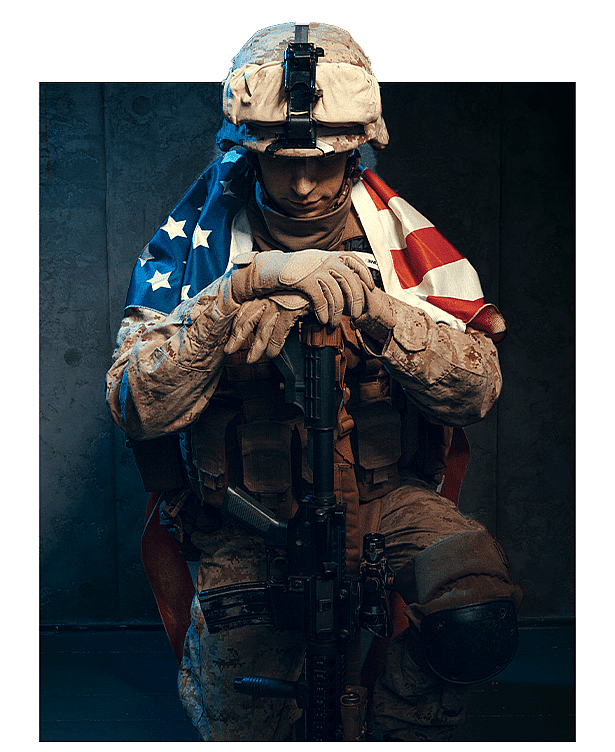Article 118 Murder
The elements of the Article 118 offense are relatively self-explanatory. The killing of a human being is unlawful when done without justification or excuse. The rule for Courts-Martial 916 describes the applicable justification and excuse defenses in the Uniform Code of Military Justice.
Premeditated Murder
- That a certain named or described person is dead;
- That the death resulted from the act or omission of the accused;
- That the killing was unlawful; and
- That at the time of the killing, the accused had a premeditated design to kill.[1]
Intent to Kill or Inflict Great Bodily Harm
- That a certain named or described person is dead;
- That the death resulted from the intentional act of the accused;
- That the killing was unlawful; and,
- That at the time of the killing, the accused had the intent to kill or inflict great bodily harm upon a person.[2]
Act Inherently Dangerous to Another
- That a certain named or described person is dead;
- That the death resulted from the intentional act of the accused;
- That this act was inherently dangerous to another and showed a wanton disregard for human life; and,
- That the accused knew that death or great bodily harm was a probable consequence of the act; and,
- That the killing was unlawful.[3]
During Certain Offenses
- That a certain named or described person is dead;
- That the death resulted from the intentional act of the accused;
- That the killing was unlawful; and,
- That at the time of killing, the accused was engaged in the perpetration of burglary, sodomy, rape, rape of a child, aggravated sexual assault, aggravated sexual assault of a child, aggravated sexual contact, aggravated sexual abuse of a child, aggravated sexual contact with a child, robbery, or aggravated arson.[4]
As a threshold matter though, certain definitional comments are worth discussion. Premeditation means that the thought of taking a life was “consciously conceived and the act or omission by which it was taken was intended.”[5] There is an imperceptibly fine line between premeditated murder and unpremeditated murder – which requires intent to kill or inflict great bodily harm. The difference, of course, is that premeditated murder carries a minimum mandatory sentence of lifetime confinement with eligibility for parole.
The difference between premeditated murder and unpremeditated murder is often a matter of discretion for convening authorities and prosecutors and nothing more. The minimum mandatory sentence of a lifetime of confinement is one of the worst features of our criminal justice system, but not likely to change given its propensity for facilitating guilty pleas for the risk-averse client. The minimum mandatory sentence provides a powerful incentive for witnesses to lie. The stakes are so high such that coercive law enforcement techniques can undermine faith in the integrity of the system.
EXAMPLE OF SPECIFIC INTENT
We say the differences in specific intent is nothing more than discretionary because in practical terms the difference is so imperceptible that juries may struggle to distinguish the two. The authors of this book have represented many service members over the last 10 years involved in combat-related homicides. Two cases come immediately to mind. They are factually very similar and involved Soldiers who killed detainees on the battlefield during or immediately following the cessation of combat activities. They both had similar states of mind. The first Soldier was convicted of unpremeditated murder and received a 10-year sentence of confinement from a jury and received parole after service 6 years. The second Soldier, whom the authors represented on appeal, was convicted of premeditated murder and is serving a life sentence with eligibility for parole. The sentence disparity for factually similar offenses is obvious.
n that regard, defense counsel’s first task in defending a murder charge under the military system is to very closely examine the issue of specific intent. Expert assistance is a must. Defense counsel will immediately want to obtain the services of a forensic psychiatrist or forensic psychologist.
Client interviews will need to explore their:
- History of trauma, including post-traumatic stress disorder;
- History of head injury, including youth sports, auto accidents, and military-related injuries;
- History of mental health issues, including depressive disorders, personality disorders, anxiety disorders, etc.; and,
- Physiological state at the time of the killing, including substance abuse, sleep deprivation, heat of sudden passion, etc.
Skillful use of expert testimony may help in convincing charging authorities to reduce a charge from premeditated murder to a lesser-included offense.
After examining the issues of specific intent, counsel will likely want to examine the factual circumstances and potential affirmative defenses under Rule for Courts-Martial 916. Those are examined in greater detail below. The most important thing that a lawyer can do in a murder crime is to preserve the crime scene. Witness testimony is the least reliable form of testimony. Its reliability is best judged against the forensic evidence. In military cases particularly, it is often not possible for military counsel to even visit the alleged crime scene. Counsel is almost always reliant on the work of military investigators – some of whom are more experienced than others.









